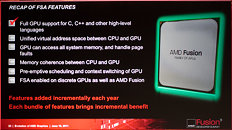- Joined
- Oct 9, 2007
- Messages
- 47,404 (7.52/day)
- Location
- Hyderabad, India
| System Name | RBMK-1000 |
|---|---|
| Processor | AMD Ryzen 7 5700G |
| Motherboard | ASUS ROG Strix B450-E Gaming |
| Cooling | DeepCool Gammax L240 V2 |
| Memory | 2x 8GB G.Skill Sniper X |
| Video Card(s) | Palit GeForce RTX 2080 SUPER GameRock |
| Storage | Western Digital Black NVMe 512GB |
| Display(s) | BenQ 1440p 60 Hz 27-inch |
| Case | Corsair Carbide 100R |
| Audio Device(s) | ASUS SupremeFX S1220A |
| Power Supply | Cooler Master MWE Gold 650W |
| Mouse | ASUS ROG Strix Impact |
| Keyboard | Gamdias Hermes E2 |
| Software | Windows 11 Pro |
The future of AMD's GPU architecture looks more open, broken from the shackles of a fixed-function, DirectX-driven evolution model, and that which increases the role of GPU in the PC's central processing a lot more than merely accelerating GPGPU applications. At the Fusion Developer Summit, AMD detailed its future GPU architecture, revealing that in the future, AMD's GPUs will have full support for C, C++, and other high-level languages. Integrated with Fusion APUs, these new number-crunching components will be called "scalar co-processors".
Scalar co-processors will combine elements of MIMD (multiple-instruction multiple-data,) SIMD (single-instruction multiple data), and SMT (simultaneous multithreading). AMD will ditch the VLIW (very long instruction word) model that has been in use for several of AMD's past GPU architectures. While AMD's GPU model will break from the shackles of development that is pegged to that of DirectX, it doesn't believe that APIs such as DirectX and OpenGL will be discarded. Game developers can continue to develop for these APIs, and C++ support is more for general purpose compute applications. That does, however, create a window for game developers to venture out of the API-based development model (specifically DirectX). With its next Fusion processors, the GPU and CPU components will make use of a truly common memory address space. Among other things, this eliminate the "glitching" players might sometimes experience when games load textures as they go over the crest of a hill.

View at TechPowerUp Main Site
Scalar co-processors will combine elements of MIMD (multiple-instruction multiple-data,) SIMD (single-instruction multiple data), and SMT (simultaneous multithreading). AMD will ditch the VLIW (very long instruction word) model that has been in use for several of AMD's past GPU architectures. While AMD's GPU model will break from the shackles of development that is pegged to that of DirectX, it doesn't believe that APIs such as DirectX and OpenGL will be discarded. Game developers can continue to develop for these APIs, and C++ support is more for general purpose compute applications. That does, however, create a window for game developers to venture out of the API-based development model (specifically DirectX). With its next Fusion processors, the GPU and CPU components will make use of a truly common memory address space. Among other things, this eliminate the "glitching" players might sometimes experience when games load textures as they go over the crest of a hill.

View at TechPowerUp Main Site





 The fact that they didn't implement it straight away into their end-products doesn't mean that they haven't been experimenting with such technologies internally. No company would invest in a product until it is financially viable to produce and there is a sufficient market for it, right?
The fact that they didn't implement it straight away into their end-products doesn't mean that they haven't been experimenting with such technologies internally. No company would invest in a product until it is financially viable to produce and there is a sufficient market for it, right?